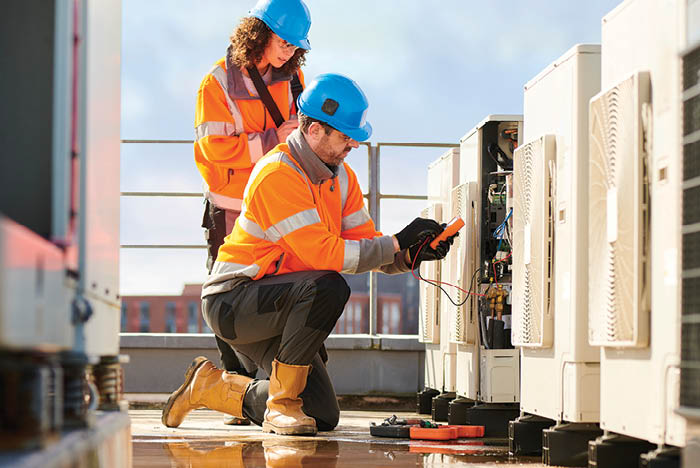Getting the most from meters and gauges
Editor's note: Although the term "reliability-centered maintenance" (RCM) may be unfamiliar to some, chances are that many facilities managers are already using several asset-management tools integral to this concept and well on their way to a complete RCM strategy without yet realizing it. In this monthly three-part series, members of the American Society for Health Care Engineering will explore common tools used in health care facilities today and how they play a role in RCM.
Believe it or not, many health care facilities managers are already performing reliability-centered maintenance (RCM) tasks, or at least condition-based monitoring (CBM).
CBM is a critical component of an RCM system and is applied to targeted failure modes, allowing earlier identification of defects than commonly applied preventive maintenance tasks during normal operation of the equipment. In layman’s terms, CBM helps to know something’s going to fail before it fails.
Everyone in this profession has meters and gauges installed on most equipment and systems. Anyone recording the information from those meters and gauges is automatically using CBM, especially if they are performing maintenance based on those readings,.
For example, almost every air handling unit has Magnehelics gauge measures or differential pressure sensors that are used to monitor the status of the air filters. If air filters are being replaced based on the change in differential pressure across the filter versus a calendar date, that is a form of CBM.
When a facilities manager performs an annual fire sprinkler system main drain test, they use the pressure gauges to record initial, residual and final pressure readings “to determine whether there has been a change in the condition of the water supply piping and control valves.”1 Again, this is a form of CBM.
Same for fire pumps. Using the pressure gauges installed on the system, pressures are recorded at no flow, 50%, 100% and 150% flow. The results of the test are used to determine performance of the pump assembly. And therefore — say it with me — “This is another form of CBM.”
And, there are many more examples. Listed below are just a few:
- Water filter differential pressure. This can indicate when the filter should be changed.
- Pump strainer differential pressure. The pressure drop will increase as particulate accumulates in the strainer.
- Chilled and heating water coils differential pressure. Over time coils can become clogged, and an increase in differential pressure can indicate when it is time to flush or backwash the coil.
- Heat exchanger differential pressure. Similar to coils, over time heat exchangers can develop rust or become clogged, indicating the need to flush or backwash.
- Monitoring motor current. An increase in current draw may indicate a need for maintenance long before a breakdown occurs.
- Temperature gauges or sensors for machinery (e.g. – motors, bearings, etc.). Overheating may indicate the need for maintenance, this can even be accomplished with a hand-held infrared (non-contact) thermometer.
- UV lamp lumens. Using a light meter to measure the lumens of an ultraviolet lamp will indicate when a lamp needs to be replaced versus just replacing it annually.
Performance monitoring — simply looking at equipment performance data — is perhaps the simplest form of CBM. Over time, equipment performance degrades, so monitoring and recording performance can provide clues as to when maintenance is required.
Performing maintenance only when it is required can save money by reducing the amount of labor and materials required. In the AHU filter example above, instead of replacing air filters every quarter whether needed or not, the life of the filters can be extended to a year or more — saving labor and the cost of the filters.
Another benefit is avoiding equipment failures and unplanned downtime. Identifying or anticipating the failure in advance and planning the downtime to repair or replace the failing component avoids the cost of the unplanned downtime. Or, worse! For example, in the fire pump scenario, monitoring the pump and motor performance is designed to ensure the fire pump is always ready when it’s needed.
From these examples and more, it’s easy to see that most health care facilities managers are already performing some form of CBM which, again, is at the core of an effective RCM system. It’s not a quantum leap to developing an RCM program when many in the field are already part of way there. RCM is just a way to make sure the right maintenance is being performed on the right equipment for the right reasons.
The next step is function and failure analysis: identify functions, functional failures, effects of failures and failure causes. This can be done independently or through the help of multiple consultants or software programs to assist with the process.
This series will continue to dig deeper into RCM and CBM, and the benefits they offer health care maintenance departments. Stay tuned for the next article, which will provide another example of an RCM or CBM task that many are already performing: thermal imaging. The article will discuss how thermal imaging has become an integral part of health care maintenance programs and is a precursor to condition-based monitoring and reliability-centered maintenance.
FOOTNOTE:
1. NFPA 25, 2011 Edition Inspection, Testing, and Maintenance of Water-Based Fire Protection Systems: 13.2.5





